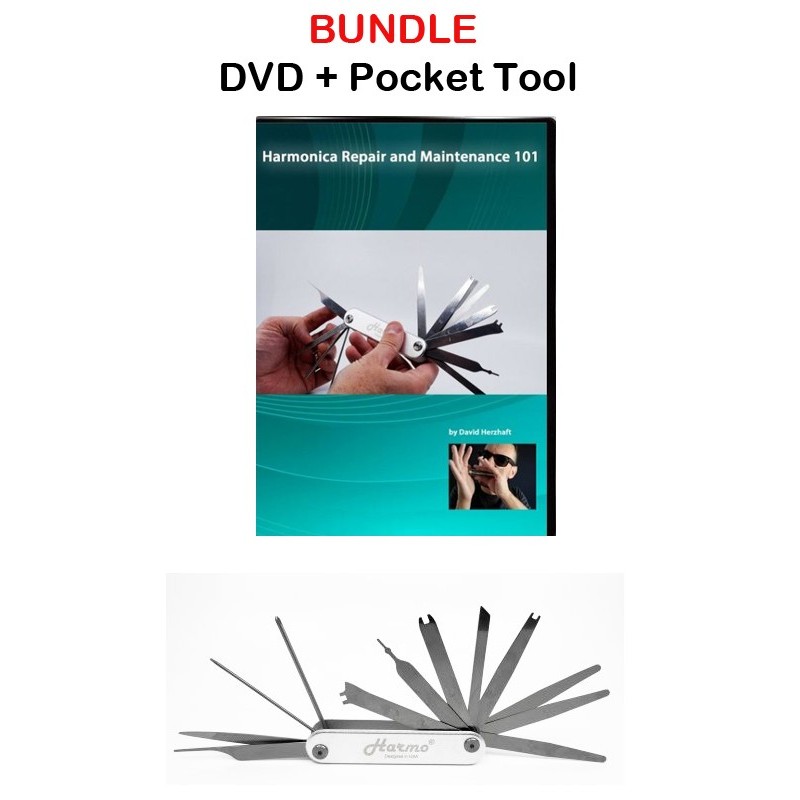














 Read the 2 reviews
Read the 2 reviews
Harmonicas are not returnable
Sorry, harmonicas cannot be returned, so please call if you'd like help choosing.
Bundle of the Harmo Pocket Tool and DVD that shows you what to do to make your harmonicas last longer
BUNDLE and save!
Pocket tool + 1h25mn DVD
The Harmo tool consists of 12 tools attached to a utility handle that makes it a breeze to carry around.
For a free video lesson about how to use the tool please go to www.harmonicaschool.com under Technique.
The Harmo tool consists of 12 tools attached to a utility handle that makes it a breeze to carry around.
You can also very easily unscrew the tool and use the tools freely.
If you have a dedicated desk it could actually even be more convenient this way.
Here is the list of tools and their original intended purpose
1 – Philips hex screwdriver: Compatible with almost all the harmonica models on the market, that's the type we mainly use for Harmo harmonicas such as the Polar, Torpedo, Custom models inside and outside screws. Even though reed-plate screws are typically smaller this screwdriver will work with both cover and reed-plate screws.
2 – flat head screwdriver: Great for any flat type screw as found in many classic German harmonica models and chromatic harmonicas.
3- File: Mostly used to re-tune reeds. File the top of the reed to make the pitch higher file the bottom to make it go lower. If your 5 draw is too low, file the top towards the tip until it reaches the desired pitch.
4 - Embossing and File tool: The side of this tool is sharp. This file can be used to emboss the tip or sides of the reed slot but can also be used to re-tune a reed as the other file provided does. They both offer a different angle so you would use this one or the other depending on your needs.
5 – Reed wrench Nb 3: Compatible with Hohner
6 - Reed wrench Nb 2 : Compatible with Suzuki and Tombo
7– Reed wrench Nb 3: Compatible with the oldest Seydel and Harmo reeds
The reed wrench tool is used when you need to re-center a reed use it carefully as a tiny amount of twist can throw the reed out of center and then that reed will not play at all. Very often it takes a couple trial and error moves to get the reed back to its center.
8 – The slim tip with a round spot type of tool is what we use to apply wax. It can also be used to work on the reed.
9 : Thick shim. We typically use these to support a reed when shaping or tuning it to prevent it from moving in the wrong direction and offer a support while working on it.
10 and 11: Light Shim. These can be useful to reopen a space between the reed and the reed-plate. If a reed gets too close to the edge it might start creating unwanted noises, rattle or rub against the reed-plate. By inserting vertically a light shim in between the reed and the reed-plate (usually on one side) and moving it up and down a couples times you can win some space back. It can also be used to slightly recenter the reed.
12 – Tip tool: Used to manipulate the reed in various ways mostly to adjust gaps. A gap is the space between the reed and the reed-plate. If the reed is too close from the reed-plate (no gap or very small gap) the reed will not produce a sound. If the reed is too far from the reed-plate it usually means too much air is wasted and leaking. Adjusting the gap is something everybody should be able to do in order to customize the way each reed respond.
Harmo is an American company founded by pro harmonica player David Herzhaft. Harmo is located in Eagle, Idaho. Harmo products are designed by a harmonica player with you in mind!
An 85mn DVD with a lot of close ups
Showcasing:
- Good technique to make your harmonicas last longer
- Basic care
- How to disassemble and reassemble your harmonica
- How to clean your harmonica
- How to tune your harmonica
- How to retune a draw and blow harmonica reed up or down
- How to recenter a reed
- How to troubleshoot common issues
- How to use the Harmo tool
- Reed gapping for overbends

